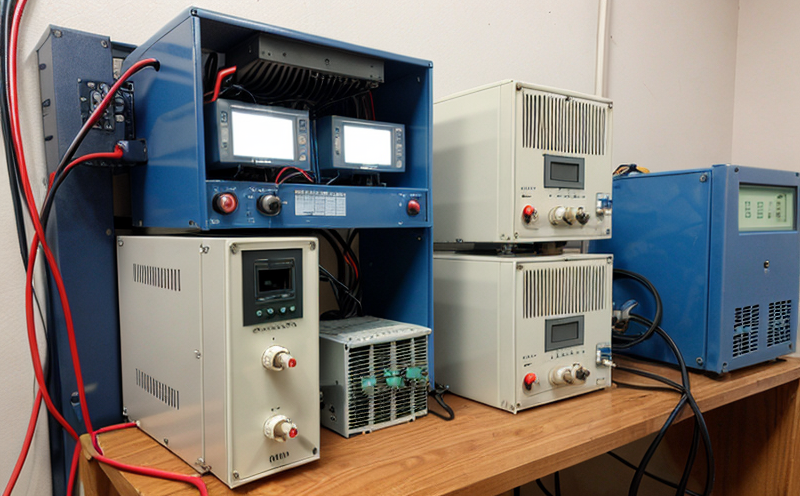IEC 62752 Residual Current Device Testing for Onboard Power Supply
The IEC 62752 standard is specifically designed to ensure the safety and reliability of residual current devices (RCDs) used in railway and transportation vehicles. These RCDs are critical components that protect onboard electrical systems from dangerous fault currents, thereby preventing fires, electric shocks, and other hazardous conditions.
The testing procedure outlined in IEC 62752 is comprehensive and covers various aspects of the RCD's performance under different operating conditions. This ensures that the device can function reliably throughout its lifecycle, especially in the harsh environments encountered in railway systems where vibrations, temperature fluctuations, and mechanical stresses are common.
One of the key features of this testing service is the ability to simulate real-world operating scenarios. This includes testing RCDs under conditions such as voltage variations, frequency deviations, and load changes that they might encounter during operation. The test setup mimics the vehicle's electrical system, providing a realistic environment for assessing the device's performance.
The testing process involves several critical steps: initial inspection of the RCD, application of specific test voltages and currents, measurement of response times to fault currents, and verification of the device’s ability to clear faults without damage. The results are meticulously documented and analyzed to ensure compliance with the standard.
For quality managers and compliance officers, this service provides assurance that all onboard power supply systems meet international safety standards. R&D engineers can benefit from detailed insights into the performance characteristics of various RCD models under different conditions, aiding in product development and optimization. Procurement teams will find value in verifying supplier compliance with these stringent testing procedures.
The IEC 62752 standard emphasizes not only the functional aspects but also the environmental robustness of RCDs. This is particularly important for railway and transportation systems where devices must operate reliably under diverse weather conditions, including extreme temperatures and humidity levels.
- Initial inspection to ensure no visible defects or damage.
- Application of test voltages and currents within specified ranges.
- Measurement of response times to fault currents.
- Verification of the device's ability to clear faults without damage.
The testing process is designed to be rigorous, ensuring that only high-quality RCDs are approved for use in railway and transportation vehicles. This not only enhances safety but also contributes to the overall reliability and longevity of these systems.
In summary, IEC 62752 Residual Current Device Testing ensures that onboard power supply systems meet the highest standards of electrical safety and performance. By adhering to this stringent testing protocol, railway operators can mitigate risks associated with electrical faults and ensure a safer transport environment for passengers and crew.
Scope and Methodology
The scope of IEC 62752 Residual Current Device Testing encompasses the evaluation of RCDs used in railway and transportation vehicles. The testing methodology is designed to cover a wide range of operational conditions, including voltage variations, frequency deviations, and load changes.
During the initial inspection, technicians carefully examine the RCD for any visible defects or damage that could affect its performance. This inspection is crucial as it ensures that only undamaged devices proceed to further testing stages. The application of specific test voltages and currents within specified ranges simulates real-world operating conditions, providing a comprehensive assessment of the device's performance.
The measurement of response times to fault currents is a critical aspect of this testing process. It helps determine how quickly the RCD can detect and interrupt fault currents, ensuring rapid protection against potential hazards. Verification of the device’s ability to clear faults without damage further ensures that it functions reliably under various stress conditions.
The methodology also includes environmental robustness tests to evaluate the RCD's performance in diverse weather conditions. This ensures that the devices are not only functional but also durable, capable of withstanding the challenging environments encountered in railway operations.
- Initial inspection for visible defects and damage.
- Application of test voltages and currents within specified ranges.
- Measurement of response times to fault currents.
- Verification of the device's ability to clear faults without damage.
The testing process is meticulously documented, with detailed records kept for each stage. This comprehensive approach ensures that all aspects of RCD performance are thoroughly evaluated, providing a robust basis for compliance verification and quality assurance.
Why Choose This Test
Environmental and Sustainability Contributions
- The rigorous testing ensures that RCDs operate reliably in diverse weather conditions, enhancing overall system performance and safety.
- This contributes to the sustainability of railway operations by minimizing the risk of electrical faults and ensuring continuous service availability.
The IEC 62752 Residual Current Device Testing not only ensures compliance with international standards but also plays a crucial role in enhancing the reliability and safety of railway systems. By adhering to these stringent testing protocols, operators can mitigate risks associated with electrical faults and ensure a safer transport environment.





